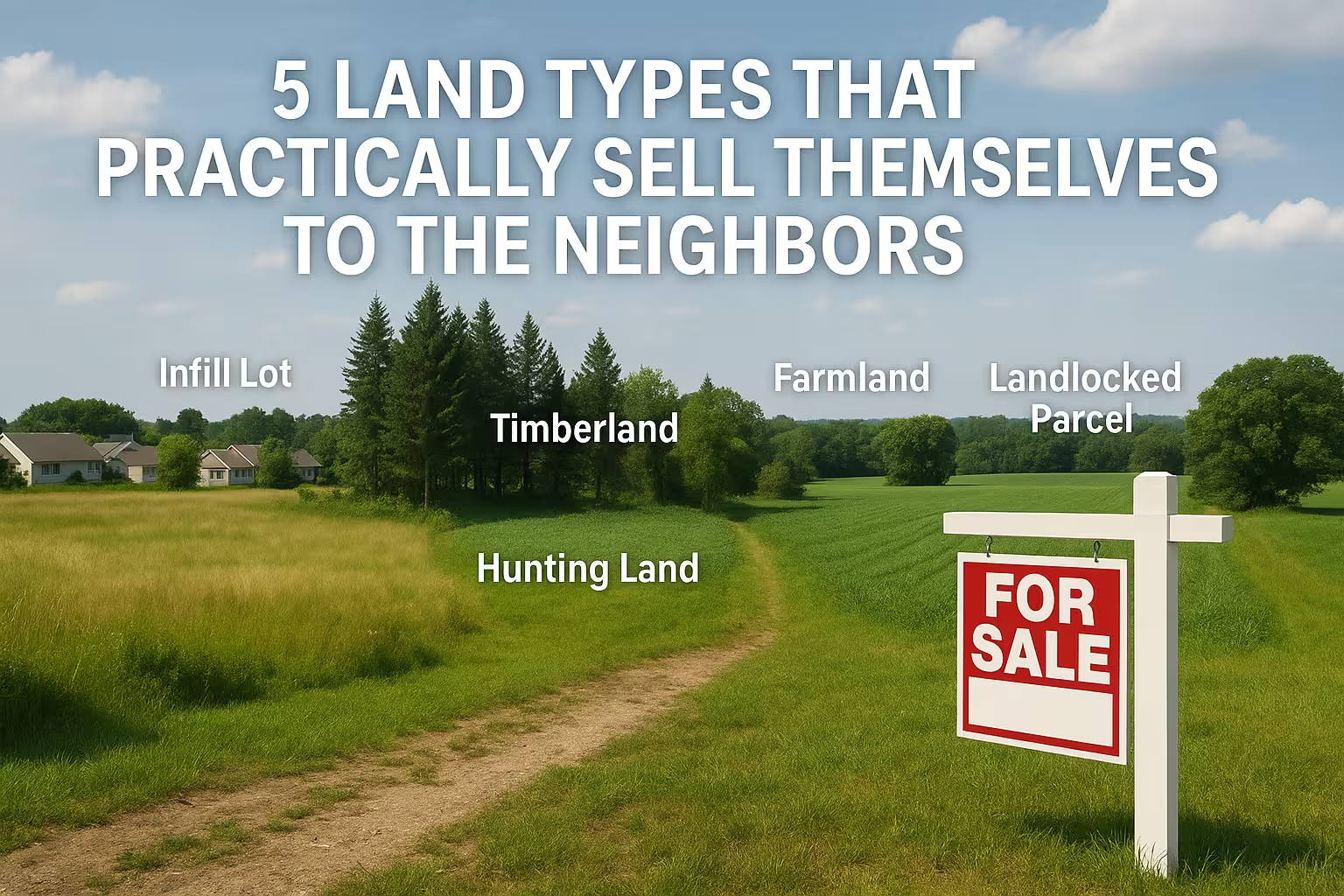When it comes to selling land, most agents turn to the usual suspects: signage, online listings, and local MLS platforms. While these channels have their place, they often fall short in one crucial way—they cast a wide net but miss the most likely buyer: the neighbor.
For certain types of land, adjoining property owners are not just potential buyers—they're your best buyers. They already own land nearby, they often have existing interest or utility for the parcel, and in many cases, they have the financial means and motivation to act quickly.
Below are five land types where neighbor marketing is especially powerful, along with messaging and timing tips for each.
1. Infill Lots
What They Are: Small vacant lots located in built-up residential or commercial areas, often between two existing structures.
Why Neighbors Are the Best Buyers:
- Neighbors may want to expand their yard or build a guest house.
- Builders or investors with projects next door may want to consolidate parcels.
- Adjacent owners may prefer to control what gets developed next to them.
Messaging Tip: Use messaging that highlights privacy, control, or increased property value:
"This rare infill lot is available right next to your property—ideal for a garage, guest home, or expanded outdoor space."
Timing Tip: Send mailers early in the selling process. Infill buyers often make quick decisions if they know about the opportunity first.
2. Timberland
What It Is: Parcels of land with mature or developing forest used for timber harvesting, conservation, or recreation.
Why Neighbors Are the Best Buyers:
- Timberland owners benefit from economies of scale.
- Adjoining owners often share the same logging contractor.
- Expansion reduces boundary disputes and increases asset value.
Messaging Tip: Appeal to the long-term investment mindset:
"Expand your timber holdings and increase long-term yield. This tract adjoins your current parcel and offers seamless access."
Timing Tip: Align mailings with local timber harvest cycles. Neighboring landowners are most receptive when planning their next harvest.
3. Hunting Land
What It Is: Wooded or rural land used for hunting deer, waterfowl, turkey, and other game.
Why Neighbors Are the Best Buyers:
- Hunters want to control adjacent land to avoid competition.
- Clubs and leaseholders may pool funds to buy surrounding parcels.
- Adjoining land creates easier access and greater privacy.
Messaging Tip: Use emotional triggers like legacy, tradition, and exclusivity:
"This hunting property borders yours—secure your perimeter and make it your family's hunting legacy."
Timing Tip: Market in late spring or early fall before hunting seasons begin. Buyers want land in place by opening day.
4. Farmland & Cropland
What It Is: Agricultural land used for growing crops or grazing livestock.
Why Neighbors Are the Best Buyers:
- Farmers seek operational efficiency by expanding adjacent acreage.
- Reduces equipment travel time and increases yield per trip.
- Many are already renting neighboring parcels and would prefer to own.
Messaging Tip: Emphasize efficiency and ownership benefits:
"This cropland borders your current fields—expanding to adjacent land holdings will increase your efficiency."
Timing Tip: Target after harvest (late fall) or pre-planting (late winter/early spring) when farmers are reviewing their land and farming operations strategy.
5. Landlocked Parcels
What They Are: Parcels with no legal road access, often only accessible through neighboring land.
Why Neighbors Are the Best Buyers:
- They may be the only viable access point.
- Buying removes future access headaches or lawsuits.
- Can be merged into their existing parcel, increasing value.
Messaging Tip: Appeal to practicality and eliminate future disputes:
"This landlocked parcel borders your property and offers a unique opportunity to expand your footprint—and remove access uncertainty."
Timing Tip: These parcels typically have fewer buyer options. Anytime is a good time to market them to neighbors.
Why Road Signs and MLS Listings Aren't Enough
Traditional marketing methods like yard signs and online listings serve a broad audience—but they often fail to connect with the one audience that matters most for land: the neighbors.
Here's why:
- Visibility is limited: Remote parcels often don't have road frontage, making signage ineffective. Additionally, they often don't have enough vehicle traffic to generate material lead volume.
- MLS platforms favor homes: Residential listings dominate, and land gets buried or overlooked.
- Neighbors may not be actively searching: But they will act when a property next door comes up.
By the time a motivated neighbor stumbles across your listing, a less-qualified buyer may already be under contract. Direct mail ensures the neighbor is first to know.
Automating the Process with AdjoiningOwner
Manually researching neighbor contact info, printing letters, and mailing envelopes can take hours. That's where AdjoiningOwner.com makes the process simple.
How It Works:
- Enter the subject parcel number.
- The system pulls up neighboring parcels using GIS data.
- You choose or customize a mailer.
- The platform prints and mails the letters on your behalf.
- Bonus: Set it and forget it—Adjoining Owner can be set to run automatically, monitoring your website or "New Listings" email, and as new listings appear the AdjoiningOwner platform kicks into action and automatically sends your standard mailers to all the adjoining owners. It can't get any more automated than this!
Why It's Effective:
- Speed: Launch a neighbor campaign in minutes.
- Precision: Mail goes to only the adjoining property owners.
- Scalability: Perfect for brokerages and investors managing multiple listings.
Final Thoughts
Not all land buyers are created equal—and in many cases, the ideal buyer is living right next door. Infill lots, timber tracts, hunting land, farmland, and even landlocked parcels all share one thing in common: high utility to adjoining owners.
Stop hoping the right person finds your listing online or drives by your "For Sale" sign. With the right targeting and the power of automation, you can reach the most likely buyer directly—faster and with less effort.
Visit AdjoiningOwner.com to see how easy it is to put neighbor-targeted land marketing on autopilot.


